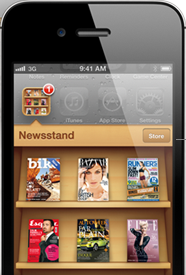
Can you assign dollars and dimes to a free digital newsstand?
There’s no doubt that publishing your digital magazine on a tablet, so that it can be downloaded in some of the world’s largest newsstands, is a good idea. 20% of your subscriptions will come directly from this huge marketplace.
It benefits your content too. Many people read from back to front in print magazines. But in a digital magazine, 95% will read front to back. They’ll see more pages (and ads for that matter). Or, they’ll pick an article are start there. With a web magazine, the reading dynamics are similar but different. It’s a fascinating thing to master if you’re a magazine editor in the 21st century. The web magazine is significantly different, and both are very different from the print magazine.
If you plan to launch a reflow-plus digital magazine—the type of edition we suggest because it’s most desired and readable—you’re going to incur more costs than if you launch a digital replica. Of course, the cost of using the top digital newsstands is technically free. Apple, Amazon and Google don’t charge you to publish your magazines.
The cost is incurred on those platforms are the remit rate, you pay 30% to Apple, 35% to Amazon and 40% to Google whenever you sell a copy or subscription. Amazon and Google’s rates are negotiable.
Of course, there are other costs involved, including design and publication. In terms of design, you may need:
- A new hire – If you decide to hire a new designer specifically for your digital issues.
- Magazine software – If your existing designers are ready and willing (more on that below).
- A partner – You may choose to outsource everything to a company (like Mequoda) that does it all for you, usually for a per-page rate.
[text_ad]
One thing most publishers will need, if they intend to publish on the big platforms, is digital magazine publishing software. When perusing digital publishing software rates, you may come across these fees:
- Initial software fee – the charge to use their software
- Startup fees – typically from companies who help you set up / design your digital magazine
- Per download fee – the flat rate or percent you pay per sale
- Per published magazine – the flat rate or percent you pay every time a new issue comes out
- Monthly fees – a flat rate you pay monthly to use the software / service
- Remit rate – the % a newsstand gets every time you sell an issue or subscription
- Hosting fees – the cost to host your files
We don’t normally advise publishing a digital replica, because they’re usually PDFs that are hard to read and have low reader satisfaction that results in low scores in newsstands. However, many publishers with smaller budgets, or those who haven’t decided to invest in their digital magazine yet, choose to start with a digital replica.
In this case, the production costs above would be less, because you’re not truly digitizing the content. A temporary thing, we hope.
Apple, Amazon and Google aren’t the only newsstands / app stores, though.
We mention Zinio a lot because they’re “the world’s largest newsstand” and they’ve been around longer than Apple, Amazon or Google newsstands. They were the newsstand before newsstands. We know that because our CEO Don Nicholas started Blue Dolphin Group, a leading online magazine retailer who merged with Zinio ten years ago, in 2005. That’s five years before the iPad…
Magzter is a global digital newsstand and book store with thousands of titles that will also launch them in the top tablet newsstands. Its cost is free, because their model is based on sharing revenue with you, the publisher.
Issuu is unique in that it can be free or paid, and you can upload to the newsstands with their free version, but you’ll have ads in it that benefit Issuu. Paid features include removing those ads ($26), a branded reader, and analytics ($35).
Then there’s the Netflix of newsstands, Next Issue, owned by six publishers: Time Inc., Condé Nast, Hearst, Meredith, News Corp. and Rogers Communications.
I could go on, but you get the picture. In business, as in life, you’ll spend more to get more. We think your digital magazine is worth investing in. We also think a web magazine is worth investing in, and we wrote about one good reason yesterday.
In the comments, share with us and our readers, which newsstands you publish on, and why!



Thank you for sharing your thoughts. Anything done poorly can be a bad user experience, but we’ve never seen data supporting high levels of user engagement for the digital replica editions. Publishers tend to like them because they’re cheap and easy, and advertisers can understand them, but the reader engagement statistics don’t support that readers find them more valuable.
Regarding “PDFs that are hard to read and have low reader satisfaction (…)” many readers perceive digital replica as more valuable to custom design. It’s because of PDF that usually is used for print. For example dozen of our customers (I am from PressPad) say they comeback into the replicas publishing (exactly what we do offer for a low monthly fee) because readers are more willing to pay for replicas. I think this is all about design.
Custom designs too often look like a mobile website (and people are used to pay nothing for website content) or game-like product. Readers want to read, not interact, because too many interaction creates distraction.